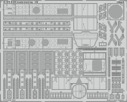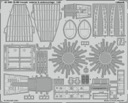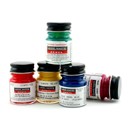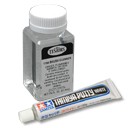

B-26K Counter Invader (Early) - US Attack Aircraft
Unassembled plastic model kit
Customize your model:
Don't forget building supplies!
In Stock (Ships in 1-3 business days)List price: $107.99
You pay: $72.89
(All prices in U.S. Dollars)

Manufacturer: ICM Models
Stock Number: ICM 48278
Scale: 1/48
View all products of type "A-26 Invader"
You pay: $72.89
(All prices in U.S. Dollars)


Manufacturer: ICM Models
Stock Number: ICM 48278
Scale: 1/48
View all products of type "A-26 Invader"
This model kit requires assembly. Cement, paint and other construction materials not included unless specifically stated in the description.
Includes early engine hoods, typical of the period when the aircraft was in use in the Congo
Detailed cockpit and accurate prototype geometry
Four different marking options:
This aviation unit, also known as 211 Squadron of the 2nd Congo Air Force Group, performed air support missions for government troops in their battles with the rebels. Since the use of bombs was prohibited, the B-26K Counter Invader inflicted fire damage with heavy machine guns and unguided rockets. Great firepower, long range and the enemy's lack of anti-aircraft defenses made these aircraft effective in the fight against insurgents.
In early 1965, some B-26K aircraft received original markings, which were used as a sign of squadron identification. She was a large black bull on a white background, copied from the label of a popular local beer brand, and the name Makasi. The name was translated as "very strong" or "strong as a bull".
Detailed cockpit and accurate prototype geometry
Four different marking options:
- B-26K 64-17644, 211th Squadron, 2nd Group, Congolese Air Force
- B-26K 64-17645, 211th Squadron, 2nd Group, Congolese Air Force
- B-26K 64-17646, 211th Squadron, 2nd Group, Congolese Air Force
- B-26K 64-17649, 211th Squadron, 2nd Group, Congolese Air Force
This aviation unit, also known as 211 Squadron of the 2nd Congo Air Force Group, performed air support missions for government troops in their battles with the rebels. Since the use of bombs was prohibited, the B-26K Counter Invader inflicted fire damage with heavy machine guns and unguided rockets. Great firepower, long range and the enemy's lack of anti-aircraft defenses made these aircraft effective in the fight against insurgents.
In early 1965, some B-26K aircraft received original markings, which were used as a sign of squadron identification. She was a large black bull on a white background, copied from the label of a popular local beer brand, and the name Makasi. The name was translated as "very strong" or "strong as a bull".

Copyright © 2005-2025 Scale Hobbyist, all rights reserved






































